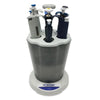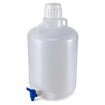- No products in the cart.
How Does PH Paper Work And What Does It Detect?
Oct
08
2021
If there is one thing that affects most life forms it’s pH. When pH levels are out of their normal range, it can affect the quality of that life form. For example, minimum alterations in the pH of the human body can cause health concerns. That’s why it’s so important to be able to measure the levels of potential hydrogen.
What Is pH And Its Uses?
The measurement of pH is part of a scale that is used to determine the acidity or alkalinity of a liquid. Potential hydrogen is a measurement of how many hydrogen ions are in a solution with the values on the scale ranging from 0 to 14. Solutions with a pH lower than 7 are acidic and solutions with a pH higher than 7 are alkaline or basic.
Different forms of liquids have different normal levels of pH. For example, pure water is neutral with a pH of 7. Blood is slightly alkaline with a pH of around 7.4. Urine has a pH level with a normal range between 4.5 and 8. Saliva has a normal pH range between 6.2 and 7.6.

Anytime these liquids fall outside the normal range, it’s an indication that there may be a cause for concern. When the pH level of water falls outside of its normal range, it’s an indication that the quality of the water has been compromised. When the pH levels of blood, urine, or saliva fall out of their normal range it’s an indication that there is a medical problem.
What Does pH Paper Detect And How Does It Work?
The level of pH is measured with pH paper and will determine if a solution is acidic, alkaline, or neutral. This is done by dipping the pH paper into a solution and observing the change in color of the paper. The paper comes with a color-coded scale with the colors representing certain values.
Here is a typical scale:
|
pH Range |
Description |
Color |
|
<3 |
Strong Acid |
Red |
|
3-6 |
Weak Acid |
Orange or Yellow |
|
7 |
Neutral |
Green |
|
8-11 |
Weak Alkaline |
Blue |
|
>11 |
Strong Alkaline |
Indigo or Violet |
The paper is treated with a chemical known as Flavin which is soluble in water and changes color in the presence of various types of solutions. In the presence of an acidic solution, the paper turns red. In the presence of alkaline solutions, the paper turns a greenish-blue. In the presence of a neutral solution, the paper turns light green.
pH paper is coated with a chemical indicator that transitions in the presence of hydrogen or hydroxide ions. Higher hydrogen ion concentration results in an acidic solution. The higher hydroxide ion concentration results in a basic or alkaline solution. Equal amounts of hydrogen ions and hydroxide ions result in a neutral condition.
pH indicators are either weak acids or bases that change color at specific pHs. Acids and bases are chemicals that exchange a proton. Chemicals that donate a proton are acids and chemicals that accept a proton are alkaline. Hydrogen donors are acid and hydrogen acceptors are alkaline. Color changes occur when acid or alkaline accepts or donates a proton.
What Is The Difference Between pH Paper And Litmus Paper?
Both litmus and pH are paper coated with a chemical substance that undergoes a reaction when it comes in contact with the liquid being tested. The litmus paper is either blue or red. With the litmus paper, a small drop of sample is placed on the paper.
Litmus paper is a pass or fail test. The blue paper turns red when the pH is acidic and the red paper turns blue when the pH is alkaline. Neutral doesn’t result in any change of color. Litmus paper determines only if the substance is acidic or alkaline while the pH paper determines the pH value. pH paper gives a more precise reading than litmus paper.
Lab Pro offers a large variety of pH paper for all types of applications. For over 40 years, Lab Pro Inc. has been committed to delivering the highest quality chemicals, lab equipment, distance learning kits, lab supplies, and cleanroom PPE apparel to medical device companies and laboratories worldwide. To learn more, visit the biggest Lab Supply showroom in California, or contact us online or at 888-452-2776.















































Was a great information to collect